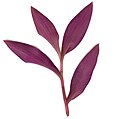Tradescantia
| Spiderworts | |
|---|---|
 | |
| Genus: | Tradescantia |
Spiderworts (Tradescantia) are a genus of an estimated 71 species of perennial plants in the family Commelinaceae, native to the New World from southern Canada south to northern Argentina. Though sometimes accounted a weed, spiderwort is cultivated for borders and also used in containers. Where it appears as a volunteer, it is often welcomed and allowed to stay. The genus takes its name from John Tradescant the elder, a 17th-century English plant collector and nurseryman.
The first species described, Virginia Spiderwort T. virginiana, is native to the eastern United States from Maine to Alabama, and Canada in southern Ontario. Virginia Spiderwort was introduced to Europe in 1629, where it is cultivated as a garden flower.
The Western Spiderwort T. occidentalis is listed as an endangered species in Canada, where the northernmost populations of the species are found at a few sites in southern Saskatchewan, Manitoba and Alberta; it is however more common further south in the United States south to Texas and Arizona.
The three species of Wandering Jew, one native to eastern Mexico, also belong to the tradescantia genus. Other names used for various species include Spider-lily, Cradle-lily, Oyster-plant and Flowering Inch Plant.
Description[edit | edit source]
They are weakly upright to scrambling plants, growing to 30-60 cm tall, and are commonly found individually or in clumps in wooded areas and fields. The leaves are long, thin and bladelike to lanceolate, from 3-45 cm long. The flowers are white, pink or purple but most commonly bright blue, with three petals and six yellow anthers. The sap is mucilaginous and clear. A number of the species flower in the morning and when the sun shines on the flowers in the afternoon they close up, but the flowers can remain open on cloudy days until evening.

Growing Conditions[edit | edit source]
Varieties[edit | edit source]
Uses[edit | edit source]
The cells of the stamen hairs of some Tradescantia are colored blue, but when exposed to sources of ionizing radiation such as gamma rays, the cells mutate and change color to pink; they are one of the few tissues known to serve as an effective bioassay for ambient radiation levels. [1]
Maintenance[edit | edit source]
Propagation[edit | edit source]
Harvest[edit | edit source]
Pests and Diseases[edit | edit source]
References[edit | edit source]
- ↑ http://www.journalarchive.jst.go.jp/english/jnlabstract_en.php?cdjournal=ggs1921&cdvol=47&noissue=6&startpage=411
-
Front view of leaves of Tradescantia pallida cv. "Purple Heart".
-
Back view of leaves of Tradescantia pallida cv. "Purple Heart".
-
Front view of leaves of Tradescantia zebrina cv. "Tricolor".
-
Back view of leaves of Tradescantia zebrina cv. "Tricolor".
-
Tradescantia ohiensis Ohio Spiderwort
| Wikiversity is collecting bloom time data for Tradescantia on the Bloom Clock |
- Book:Horticulture/Finder/Types/Plants, Herbaceous
- Book:Horticulture/Finder/Seasons/Spring
- Book:Horticulture/Finder/Seasons/Summer
- Book:Horticulture/Finder/Lifetime/Perennial
- Book:Horticulture/Finder/Attractions/Butterflies
- Book:Horticulture/Finder/Native/North America
- Book:Horticulture/Finder/Native/South America







